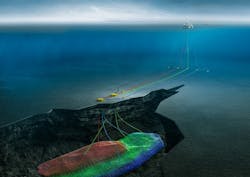Norway sanctions two subsea tiebacks
Offshore staff
STAVANGER, Norway – Norway’s Minister of Petroleum and Energy has approved the plans for development and operation for the VNG Norge-operated Fenja field and the Aker BP-operated Ærfugl in the Norwegian Sea.
Fenja (previously named Pil/Bue) will be developed with two subsea templates with six wells (three producers, two water injectors and one gas injector) tied back to the Njord A platform for processing and storage and export via the Njord B FSO.
Discovered in 2014, the Fenja field is in block 6406/12 about 120 km (75 mi) north of Kristiansund, and about 30 km (19 mi) southwest of the Statoil-operated Njord field.
VNG Norge estimates that the field contains recoverable resources of about 100 MMboe, mostly oil.
The licensees in PL586 are VNG Norge AS (operator, 30%), Point Resources AS (45%), and Faroe Petroleum Norge AS (25%).
The partners are planning to invest NOK10.2 billion ($1.22 billion), with start-up expected in 2021 and a planned field life of 16 years.
Aker BP describes Ærfugl (ex-Snadd), including the Snadd Outer structure, as a unique gas condensate field, almost 60 km (37 mi) long and only 2-3 km (1.2-1.8 mi) wide, west of the Snadd field and close to its Skarv FPSO, 210 km (130 mi) west of Sandnessjøen.
Snadd was discovered in 2000 and Snadd Outer in 2012.
Under the first NOK4.5-billion ($543-million) phase, three new production wells will be drilled on the southern part of the field tied and tied into the FPSO via a trace heated pipe-in-pipe flowline, along with the existing A-1 H well. First production is targeted for October 2020.
Phase 2 - NOK4 billion ($483 million) - remains subject to further maturation, but provisionally will add two wells to the northern part of the field and one on Snadd Outer, also tied into the FPSO, with an estimated production start in late 2023.
Aker BP estimates remaining reserves for the full-field development at around 275 MMboe.
04/09/2018
